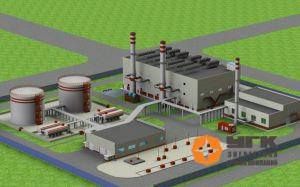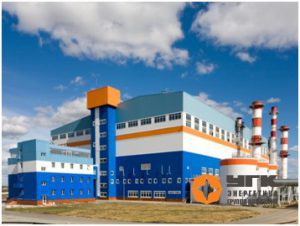One of the most economically viable renewable energy sources (RES) is waste-to-energy plants with thermal power stations, where municipal solid waste (MSW) is incinerated – mini-CHP (power plants) on solid municipal waste.
The “UGK-Energetika” Group provides a full range of services for the design, manufacturing, and construction of waste-to-energy plants that generate electricity from MSW (RDF and other wastes) using steam boilers with vortex fireboxes and steam turbines, as well as the production of waste sorting complexes:

Waste-to-energy plants generating electricity from “UGK-Energetika” are today’s strategy for ridding Russia, the CIS, and other countries of waste. The feasibility of these plants is justified not only by the traditional method of “waste management” but also by the limited conditions for implementing separate waste collection in the country.
As is known, municipal solid waste – a fuel comparable in calorific value to peat and some grades of brown coal – is produced where electricity is most needed, i.e., in large cities, and as long as humanity exists, it has a guaranteed predictable renewal. The operation of mini-CHP (power plants) on MSW at waste-to-energy plants does not depend on natural conditions and geographical location (unlike, for example, solar, wind, tidal, or geothermal installations), and in addition to energy generation, it solves an important social task – the disposal of waste generated in the process of human activity.
The optimal choice of the type of energy produced depends on local needs for thermal and electrical energy, plant capacity, existing energy purchase tariffs, etc., and significantly affects the cost and economy of the plant operation as a whole. For example, estimated calculations for MSW with a calorific value of 10 MJ/kg show that the total specific costs for the construction of a waste-to-energy plant decrease by approximately 25-35% as its capacity increases from 100 to 300 thousand tons of MSW per year. Revenue from the sale of generated energy primarily depends on the type and quality of the sold energy. For example, in Austria, electricity is bought at a price of 45 euros per 1 MWh with guaranteed supply to the consumer and 25 euros per 1 MWh if electricity supply depends on the supplier’s operating mode. Heat supply tariffs are 10 and 6 euros per 1 MWh, respectively.
The “UGK-Energetika” Group has thermal and biological process technologies for generating energy from MSW. This approach not only prevents the accumulation of hazardous waste fractions in the environment but also reduces the percentage of natural resources consumed by humans. In short, it is an effective solution to two pressing issues of modern society.
Innovative Waste Incineration Technologies for Energy Generation at Waste-to-Energy Plants
When operating a steam boiler with vortex fire technology in a mini-CHP, at the first stage of pyrolysis, oxygen-free degassing of the placed waste (raw fuel) occurs at t = 400-600°C. The generated gases are then combusted with an excess of air oxygen, reaching flame temperatures (decomposed gas mixture) within t = 1150-1400°C. The gases are burned in the vortex firebox and directed into the steam boiler, where they undergo final and almost instantaneous combustion. At this temperature and physical-chemical reaction time, all compounds of dioxins, dioxides, furans, and other hazardous substances are destroyed, converting into atomic and simplest states.
To prevent the secondary formation of harmful emissions (from “precursor” molecules), the installation is equipped with a patented energy-efficient steam boiler and an exhaust gas quenching device at the boiler exit, allowing rapid and effective Delta T removal (over 1000°C) in less than 0.5 seconds from 1250-1400 to 200°C and below. This step of “instant” cooling – quenching the exhaust gases, consisting of simple and atomic components – prevents the reformation of dangerous and harmful compounds (secondary formation) due to the lack of time and energy for secondary formation.
Main Technical Characteristics of Mini-CHP Power Plants on MSW at Waste-to-Energy Plants by “UGK-Energetika” Group:
Maximum Concentrations of Harmful Impurities in Flue Gases According to European Standards (2000/76/EC):
| Parameters | Per Hour | Per Day | ||
| 97% | 100% | |||
| CO | – | <50 | <50 | mg/m3 |
| SOx in the form of SO2 | 50 | <100 | <50 | mg/m3 |
| HF | 2 | 4 | 1 | mg/m3 |
| Dust | 10 | 30 | 10 | mg/m3 |
| Total Organic Carbon (TOC) | 10 | 20 | 10 | mg/m3 |
| NOx in the form of NO2 | 200 | 400 | 200 | mg/m3 |
| During Measurements | ||||
| Cd + Tl | — | 0.05 | — | mg/m3 |
| Hg | — | 0.05 | — | mg/m3 |
| Sb, As, Pb, Cr, Co, Cu, Mn, Ni, V | 0.5 | </ | mg/m3 | |
| Dioxins/Furans. | — | 0.1 | — | ng/m3 |
Standard conditions: 273K, 1013 mbar, 11 % O2, adjustment only when > 11% O2
Nominal Data for Design
| Design Parameters | ||
| Fuel | MSW | |
| Quantity | kg/h | 21,120 |
| Moisture | w-% | 15-20 (approximately) |
| Ash Content | t/24h | 25 (approximately) |
| LHV | kJ/kg | 10,000 |
| Elementary Analysis | ||
| N | w-% | n/a |
| S | w-% | n/a |
| Cl | w-% | n/a |
| F | w-% | n/a |
All consumables and waste are calculated at the design stage.
Black or non-ferrous metals that may remain in the fuel stream must be removed using a drum magnet and an eddy current separator.
Small and medium-scale energy production today is a promising, relevant, profitable, and in-demand business direction that will maximize the protection and growth of your investments for many years.
More waste – more benefits! We are a team of professionals and top-notch specialists in energy production from waste!
To apply for the construction of a turnkey waste incineration plant with power generation on MSW, you need to fill out an online questionnaire.
For all other questions, please contact our engineers:
| Yekaterinburg | Russia, CIS | |
| +7 (343) 272-31-80 | 8 (800) 201-71-60 | ka@urgk.ru |
| +7 (343) 272-31-82 | office@urgk.ru |